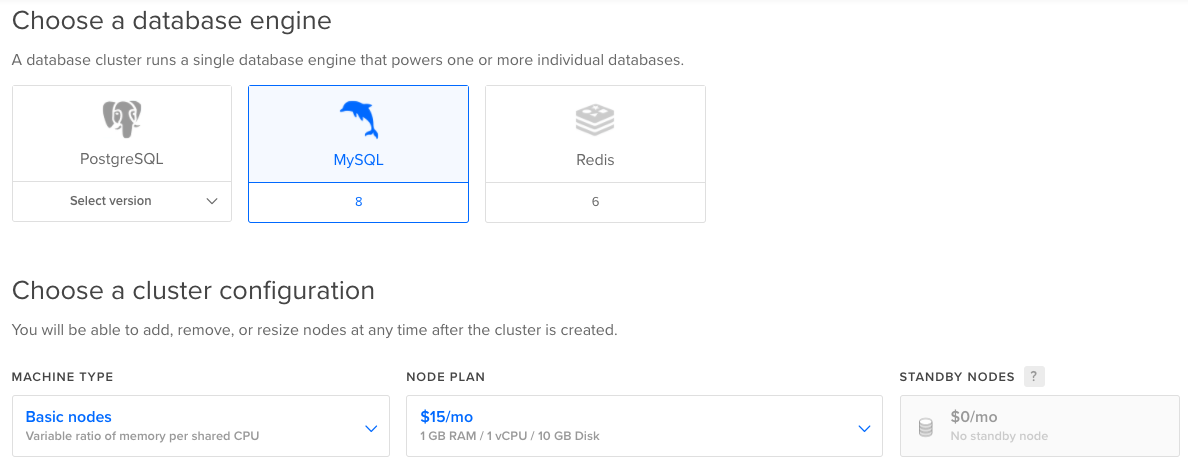Create MySQL Database
- From the left-hand navigation of the Digital Ocean dashboard, under the Manage section, choose Databases
- Click on Create in the top left, then in pull-down choose Databases
- Under Create a database cluster, choose MySQL 8; choose a node plan – if you are going to have high-volume traffic, you will want more memory/CPU/disk space. For basic testing, you can choose the Basic 1G/1CPU/10GB Disk plan, but note that per this article the Basic machine types use Shared CPU.
- Choose the datacenter where your Stream Manager droplet resides.

- Under Finalize and create choose a unique database cluster name (or accept the assigned name) and select your project, then click on Create a Database Cluster.

- After the database is provisioned, you can secure and configure the database cluster. NOTE: this can take 10-15 minutes, so now is a good time to get up and stretch your legs.
- Add trusted sources – from the Overview tab, click on Secure this database cluster by restricting access. in the
TRUSTED SOURCESsection. Click on the Edit button next to Trusted Sources. Find your stream manager and your terraform server in the Add Trusted Sources pull-down; you can also add your IP address if you wish. Then click on Allow these inbound sources only. - Make a note of the time for scheduled updates; if you want to change that time you can modify that in settings.
- Click on the Users & Databases tab. Add a new database called
cluster. Note: this database will be populated by the Stream Manager at startup.
- Add an autoscaling admin User account to the database. A secure password will be generated – make a note of that password (or you can reset it if you like).
Database Connections
You will need 3 database connections for each node (origin, edge, etc). In addition, each incoming publish and subscribe request queries the database, so for production traffic, you will likely want to choose the highest available database node type.
NOTE: For production, it is suggested that you also enable a standby database node.
Digital Ocean-Hosted MySQL backend connections
Digital Ocean Hosted MySQL nodes can have up to 75 simultaneous connections per gigabyte of usable memory, rounded down to the nearest gigabyte. Usable memory is the total memory on the node minus approximately 350 MB of overhead for the operating system and management.
| Plan Size | Available Backend Connections |
|---|---|
| 1 GB RAM | 75 |
| 2 GB RAM | 150 |
| 4 GB RAM | 225 |
| 8 GB RAM | 525 |
| 16 GB RAM | 1,050 |
| 32 GB RAM | 2,175 |
| 64 GB RAM | 4,425 |
max_connectionsis set to one connection higher to accommodate a system process that does not count against the node’s connection limit. For example, a 4 GB node has roughly 3.6 GB of usable memory. It can have up to 3 * 75 = 225 connections and its max_connections is set to 226.
Optional – Run MySQL on a Droplet
You may choose to run MySQL on a droplet instead of via the Databases to minimize costs or for more management options (for example, you can set a higher max_connections value than the managed databases allow). The upside to using the Digital Ocean database is the standby node option, for database failover.
CRITICAL NOTE: If you run the database on a droplet, you must create a firewall for that droplet with inbound port 3306 open only to the stream manager instance(s), and SSH port 22 only open to administrators’ IP addresses.
- Create a new droplet from the optimized image that you created. It is recommended that you use a c-4 or c-8 instance, depending on your anticipated user load.
- Install NTP and unzip:
apt-get install unzip ntp - Install MySQL:
apt-get install mysql-server– during the MySQL installation, you will be prompted to set the root password – make a note of what you set this to. - IMPORTANT: Modify
/etc/mysql/mysql.conf.d/mysqld.cnfcommenting out the line:bind-address = 127.0.0.1by pre-pending with a#; Also, uncomment themax_connectionsline and set that to100000(max_connections = 100000). Additionally, you should add the parameterskip-log-binto themysqld.cnfto prevent excessive logging. (NOTE: for a development environment, you may want to run Stream Manager, Terraform and MySQL all on the same droplet. In this case, you would leave the defaultbind-addresssetting) - Restart MySQL service
systemctl restart mysqlto apply the above settings - Add non-root user:
- Connect to database as root
mysql -u root -p(enter root password). - Create new user: at
mysql>prompt:CREATE USER 'mynewuser'@'%' IDENTIFIED BY 'goodPassword';wheremynewuseris your dbadmin andgoodPasswordis your secure password. - If you are successful, you will see
Query OK, 0 rows affected (0.00 sec) - Apply privileges to the new user:
GRANT ALL PRIVILEGES ON * . * TO 'mynewuser'@'%'; - Reload the privileges to make sure the new ones are in place:
FLUSH PRIVILEGES;
- Connect to database as root
- Create
clusterdatabase:- Connect with the new user: type
quitto log out the root user, thenmysql -u mynewuser -p - Create database:
CREATE DATABASE cluster;
- Connect with the new user: type
- Add Cluster schema:
- Download the Red5 Pro Server Distribution, and unzip it on your server.
- Navigate to
{red5prohome}/webapps/streammanager/WEB-INF/sql/to find thecluster.sqlfile. - Run the SQL script:
mysql -u mynewuser -p cluster < cluster.sql(you will be prompted to enter the password that you set above).